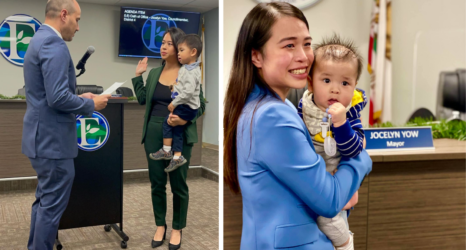The full-length version of this post appears in the Daily Hampshire Gazette. Republished with author permission.
I teach courses at Smith College on women’s rights and feminist movements; over the last two years, my students and I have closely followed the Trump administration’s aggressive rollback of women’s rights.
With increasing urgency, we have studied the erosion of women’s reproductive rights and the attack on protections against rape and sexual harassment on college campuses. We are appalled at the refusal of Congress to renew the Violence Against Women Act (VAWA), which funds critical services for women fleeing intimate partner violence. At the same time, seeing the explosion of new feminist activism has been exhilarating and inspiring.
The Women’s Marches, #MeToo and Indivisible activism have transformed the political landscape—and contributed to the historic 2018 midterm election returns, in which record numbers of women ran and won political office.
As we head into the challenge of the national elections in 2020—when we will also celebrate the 100th year of women’s right to vote—I spoke to Katherine Spillar, executive editor of Ms. magazine and executive director of the Feminist Majority Foundation, about what role feminists played in the 2018 results, and how we can continue expanding on our victories.
@MsMagazine editor Kathy Spillar (L) being interviewed by Sophian editor Claudia Olson '22 (R) with Smith professor Carrie Baker (C). Interview out next Thursday! pic.twitter.com/fm0Zat10F7
— The Sophian (@smithsophian) January 25, 2019
What impact did feminists have on the elections?
The energy released by the historical Women’s Marches of 2017 and 2018 helped to produce a flood of new candidates and activists. Women’s rights organizations, including Feminist Majority, made massive efforts to elect feminist women to federal and state office. Feminist candidates in Congressional races shifted the balance of power in the U.S. House, accounting for over 60 percent of Democrats’ gains. Democratic candidates earned 8.8 million more votes than Republicans and won 43 seats in the House for a net gain of 40 seats. In hard-fought contests across the country, feminists defeated longtime incumbents, overcoming massive gerrymandering and voter suppression to flip seat after seat from red to blue. Voter turnout in the midterms was estimated at 50 percent of the voting-eligible population—the highest rate in more than five decades.
You’ve said that we have the most diverse new group of representatives in history. Tell me about that.
The election featured historical breakthroughs: the first Native American women elected to Congress, the first Latinas elected to represent Texas, the first Muslim women elected, and the first Black women to be elected from states in New England, including Ayanna Pressley from Massachusetts. Two 29-year-old women won seats in the House—Alexandria Ocasio-Cortez from New York and Abby Finkenauer from Iowa—the youngest women ever elected. Among the newly elected women in the House are teachers and social workers, refugees and veterans, lawyers, former state legislators, experts on the homeless crisis, early childhood education and human trafficking; healthcare professionals; and a mother who lost her teenage son to gun violence. A pediatrician will be the only woman among 16 doctors in Congress. You can read the latest issue of Ms. magazine and Ms. online for detailed information about amazing new feminists in Congress.
The presence of more women in Congress will have important impacts on policy debates, given their different backgrounds and varied life experiences. They will bring much-needed perspectives and ideas to the ensuing battles over health care, reproductive rights, gun reform, immigration, the environment, voting rights, sexual harassment and assault, LBGTQ rights, budget priorities, military spending and foreign policy. They will hold the line for women’s rights, stopping the reactionary attacks in Washington.
How did women and feminists do at the state level?
Wins for women were massive in state legislatures as well. Record numbers of women ran and won. When the dust had settled, we totaled 2,112 women elected to the 7,383 state legislative seats at stake. These women, by far mostly Democrats, will join those from states without legislative elections in 2018 to total 2,019 or at least 28 percent of state legislative seats, smashing previous records and bringing about the largest electoral gain in more than a decade. Both the Nevada Assembly and Colorado House of Representatives will be gender balanced, with nearly equal numbers of women and men. Nevada actually has a majority female legislature—the first in the country.
Feminist women also did well in statewide races, winning governorships in Maine, Kansas, Michigan and New Mexico. Women took office as secretaries of state in Colorado, Arizona and Michigan, and attorneys general in Michigan, New York, and Delaware. In a first, all statewide executive offices in Michigan—governor, attorney general and secretary of state—are now held by women.
At the state level, public education was a major motivating issue for voters in state legislative races. Following teacher strikes and walkouts over cuts in education funding and inadequate teacher pay in states like Oklahoma, West Virginia, North Carolina, Colorado and Arizona, public school teachers ran for elective office in record numbers. More than 80 of the 200 members of the American Federation of Teachers who ran were elected to state legislatures.
Was there a gender gap in voting patterns?
Yes. The gender gap in voting was as great as any election in the past 20 years. According to the national Edison Research exit poll, 59 percent of women voted for Democratic House candidates in races across the country, compared to 47 percent of men, a 12-point gender gap. Among young women 18 to 29 years old, 67 percent voted Democratic versus 32 percent who voted Republican. The gender gap is driven by the different perspectives men and women hold on a range of issues—for example, the role of government in ensuring access to health care, including abortion and birth control, and social safety net programs like supplemental food support (SNAP). And, issues like sexual harassment and the role of military action versus diplomacy in our foreign policy. These differences in views drive voting preferences, and have only grown over time to become decisive in determining the outcome of race after race.
What are your hopes for the new Congress?
Self-avowed feminist Nancy Pelosi is again speaker of the house, second in line to the presidency and the most powerful woman in government. Pelosi has said she intends to make women’s issues a priority, pushing forward long-stalled legislation to address the wage gap and sexual harassment, reauthorizing VAWA, defending the ACA, addressing the environment, and blocking further rollbacks in voting rights and civil rights. Rep. Nita Lowey from New York will chair the powerful Appropriation Committee and will also play a key role in these issues. She has listed among her priorities increasing funding for child care and early education programs and blocking Republican efforts to reduce spending on family planning.
With Brett Kavanaugh and a far-right conservative majority on the Supreme Court, women’s rights are more at risk than ever. What can be done to protect those rights?
We need to finally ratify the Equal Rights Amendment (ERA). We are already gearing up for the off-year elections in 2019 for the Virginia state legislature that will, in all probability, be crucial for ratifying the ERA. Early in 2017, Democrats gained control of the Nevada House and Senate, and ratified the ERA. Then, in May of 2018, the Illinois House and Senate ratified the ERA. As of now, 37 of the 38 states required to amend the Constitution have ratified the ERA. Virginia could become the 38th and final state needed to add the ERA to the Constitution. There are also strong ERA movements in North Carolina and Arizona. The ERA was first sent to the states for ratification in 1972. A resolution to remove the arbitrary deadline imposed by Congress has been introduced in this session of Congress, as was a start-over ERA resolution.
More and more people are understanding the need for the ERA. The ERA would elevate the level of scrutiny the courts would apply in assessing whether government laws or policies have a discriminatory impact on the basis of sex. It would prevent the President or Congress from passing discriminatory laws or enacting discriminatory policies. For example, right now the Trump Administration is pushing to enact a policy to allow employers to deny their female employees coverage of birth control in insurance policies. An ERA could be used to fight these kinds of harmful and discriminatory policies. The ERA could also be used to ensure local law enforcement agencies do not discriminate against women in responding to crimes of violence like domestic violence and rape; for example, failing to process rape evidence kits in a timely manner, or failure to enforce restraining orders in domestic violence cases.
What are your hopes for the future?
Women now constitute just 23.6 percent of members of Congress (106 Democrats and 20 Republicans). Going into the midterms, the U.S. ranked No. 103 worldwide in women’s representation in government. We still have a long way to go. But the midterms have given us tremendous momentum. Propelled by women of color, young women and college-educated women, and women’s collective victories in Congress, state legislatures and statewide offices have laid the groundwork for even larger gains in 2020. It shows that flooding the ticket with feminist candidates, including challenging incumbents in districts that would otherwise seem impossible, is one of the critical paths to equal representation. The feminist movement must stay focused on achieving equal representation, if the policies, laws, and programs — at every level of government — are to meet the needs of half of the population and ensure all of us can enjoy equal protection under the laws of our country.





